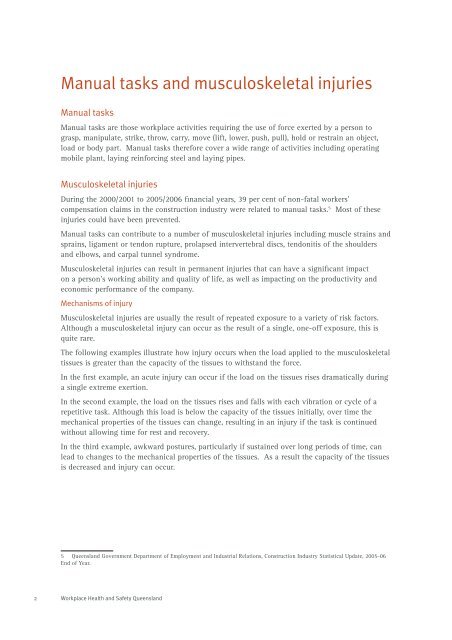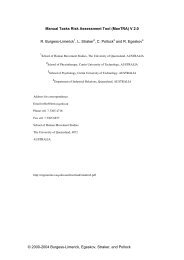d6 - Burgess-Limerick
d6 - Burgess-Limerick
d6 - Burgess-Limerick
- No tags were found...
Create successful ePaper yourself
Turn your PDF publications into a flip-book with our unique Google optimized e-Paper software.
Manual tasks are those workplace activities requiring the use of force exerted by a person to<br />
grasp, manipulate, strike, throw, carry, move (lift, lower, push, pull), hold or restrain an object,<br />
load or body part. Manual tasks therefore cover a wide range of activities including operating<br />
mobile plant, laying reinforcing steel and laying pipes.<br />
<br />
During the 2000/2001 to 2005/2006 financial years, 39 per cent of non-fatal workers’<br />
compensation claims in the construction industry were related to manual tasks. 5 Most of these<br />
injuries could have been prevented.<br />
Manual tasks can contribute to a number of musculoskeletal injuries including muscle strains and<br />
sprains, ligament or tendon rupture, prolapsed intervertebral discs, tendonitis of the shoulders<br />
and elbows, and carpal tunnel syndrome.<br />
Musculoskeletal injuries can result in permanent injuries that can have a significant impact<br />
on a person’s working ability and quality of life, as well as impacting on the productivity and<br />
economic performance of the company.<br />
<br />
Musculoskeletal injuries are usually the result of repeated exposure to a variety of risk factors.<br />
Although a musculoskeletal injury can occur as the result of a single, one-off exposure, this is<br />
quite rare.<br />
The following examples illustrate how injury occurs when the load applied to the musculoskeletal<br />
tissues is greater than the capacity of the tissues to withstand the force.<br />
In the first example, an acute injury can occur if the load on the tissues rises dramatically during<br />
a single extreme exertion.<br />
In the second example, the load on the tissues rises and falls with each vibration or cycle of a<br />
repetitive task. Although this load is below the capacity of the tissues initially, over time the<br />
mechanical properties of the tissues can change, resulting in an injury if the task is continued<br />
without allowing time for rest and recovery.<br />
In the third example, awkward postures, particularly if sustained over long periods of time, can<br />
lead to changes to the mechanical properties of the tissues. As a result the capacity of the tissues<br />
is decreased and injury can occur.<br />
5 Queensland Government Department of Employment and Industrial Relations, Construction Industry Statistical Update, 2005-06<br />
End of Year.




